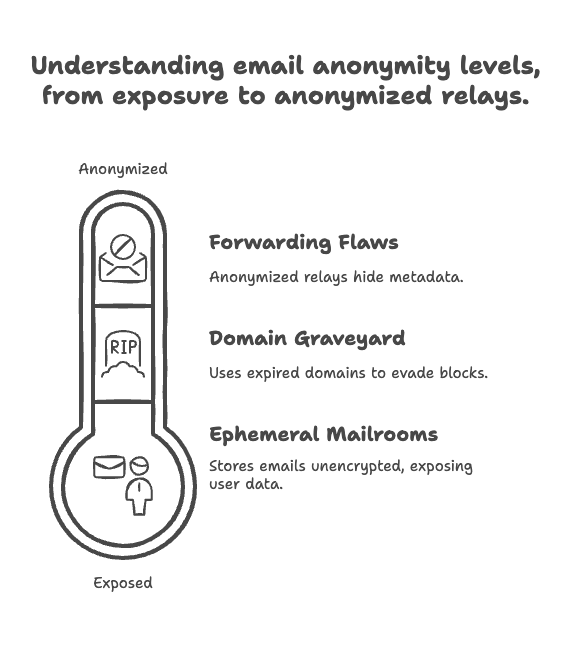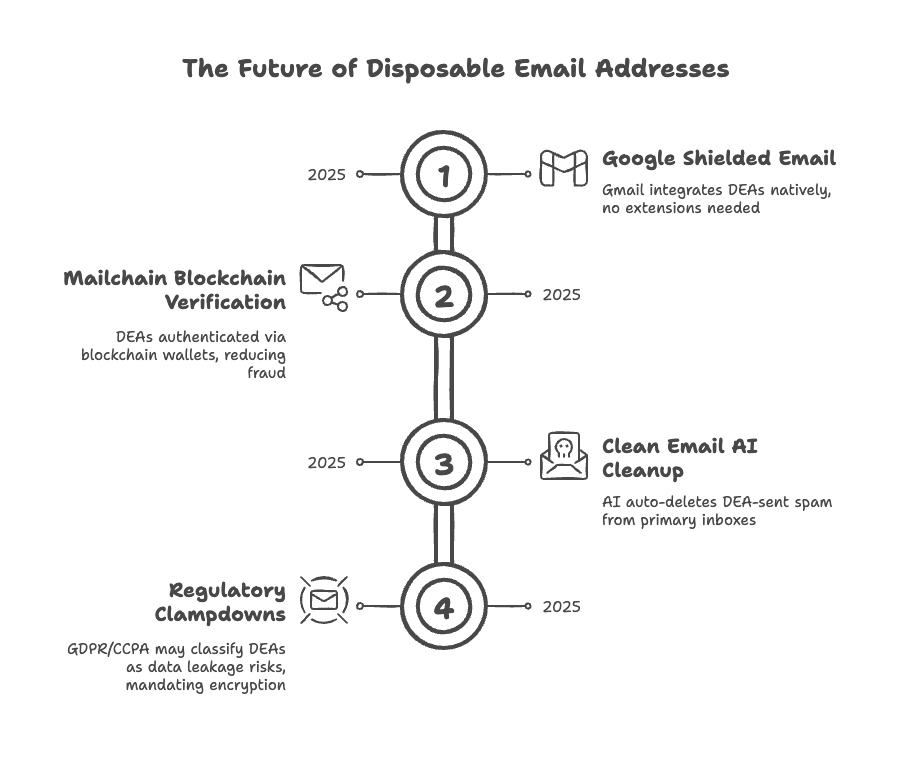Disposable Email - Free Temp Mail Generator
Let’s cut through the noise: over 60% of emails in the U.S. now use disposable addresses, a surge driven by rampant data breaches and sophisticated tracking. Your primary inbox isn’t just a spam magnet—it’s a privacy black hole and identity theft risk rolled into one. Disposable email addresses (DEAs) are your digital invisibility cloak, but their mechanics, risks, and evolution demand deeper exploration. Modern services like Temp-Mail and Guerrilla Mail have evolved beyond sketchy "trash mail" sites, yet critical gaps in security and functionality persist.
🔧 How Disposable Email Really Works: Architecture and Limitations
Behind the curtain, DEAs operate on a sophisticated but vulnerable infrastructure:
- Domain Graveyard: Services buy expired domains (e.g.,
@dinosaurmail.net) or use algorithmic domain generation to stay ahead of blocks. - Ephemeral Mailrooms: Incoming emails hit centralized servers with virtual "inboxes" that auto-shred messages after 10 minutes to 48 hours. Crucially, 70%+ free services don’t encrypt stored emails, leaving data exposed.
- Forwarding Flaws: Emails routed to your main inbox can leak metadata (IP/location) unless services like 33Mail or AnonAddy use anonymized relays.
⚠️ The Hotel Front Desk Analogy Flaw: Unlike physical mailrooms, public DEA inboxes (e.g., Maildrop) let anyone access "your" emails if they guess the address—a risk for password resets or verification codes.

🛡️ Security Deep Dive: Beyond Spam Shielding
Disposable emails are privacy tools—not security solutions. Here’s the nuanced reality:
| Protections Offered | Critical Vulnerabilities |
|---|---|
| Spam isolation from primary inbox | ❗ Zero end-to-end encryption in 90% of free services |
| Anonymity from data brokers | ❗ Public inboxes (Maildrop, Mailinator) allow unrestricted email viewing |
| Breach containment | ❗ Domain blocking by banks/government sites limits utility |
Case Study: A 2024 study found 62% of DEAs used for crypto sign-ups were compromised via exposed inboxes or DNS hijacking.
💡 Pro Solution: Pair DEAs with encrypted aliases (e.g., Apple Hide My Email, DuckDuckGo Email Protection) that mask your identity and encrypt content. Never use DEAs for sensitive data.
🌐 Top 8 Disposable Services: Beyond the Basics
Expand your arsenal with these tested options:
- Temp-Mail Pro ($10/month)
- Upgrade Reason: Removes ads, adds custom domains, and extends storage to 30 days—critical for trials.
- Risk: Frequent domain blacklisting by Shopify/Google.
- Guerrilla Mail
- Hidden Perk: "Scrambled Addresses" (e.g.,
[email protected]) thwart inbox snooping better than fixed aliases. - Downside: 60-minute email lifespan loses travel bookings/event confirmations.
- Hidden Perk: "Scrambled Addresses" (e.g.,
- EmailOnDeck
- Crypto Edge: Accepts Bitcoin for premium tiers with anonymous sending—ideal for whistleblowers.
- Caution: Free emails vanish unpredictably (often mid-day).
- AdGuard Temp Mail
- Unique Feature: 7-day retention after browser close + ad-blocking integration.
- Limit: No attachment support—blocks receipts/verification docs.
- Yahoo Disposable Addresses
- Enterprise Secret: 500 aliases for Yahoo Mail Plus users (
[email protected]). - Perk: Integrates natively with your main inbox—no third-party risks.
- Enterprise Secret: 500 aliases for Yahoo Mail Plus users (
- Mail7.io
- Developer Gold: Private domains + API for automated testing (e.g., CI/CD pipelines).
- Use Case: QA teams simulate user flows without cluttering real accounts.
- 33Mail
- Lifetime Alias: Forwards
[email protected]to your main inbox permanently. - Power Move: Disable aliases that get spammed—no more "Unsubscribe" battles.
- Lifetime Alias: Forwards
- SimpleLogin (Acquired by Proton)
- Security Beast: Open-source, encrypted forwarding with PGP support.
- Ideal For: Journalists needing anonymity without DEA fragility.
🧨 The Unspoken Risks: Beyond Account Lockouts
- Reputation Damage: Businesses using DEAs face 27% higher email bounce rates, crushing sender scores and inbox placement.
- Data Fragmentation: Lost access to purchase receipts/2FA codes when DEAs expire complicates disputes and account recovery.
- Legal Gray Zones: DEAs used for harassment (e.g., Harvard bomb threat case) enable tracing via server logs and TLS fingerprints.
- Ad Malware: Free DEA sites (e.g., 10MinuteMail) run malvertising campaigns—35% trigger drive-by crypto mining.
🔮 The Future: DEAs Get Smarter (and More Regulated)
- Corporate Integration: Google’s "Shielded Email" (2025) bakes DEAs into Gmail—no extensions needed. Expect Outlook/Apple follow-suit.
- Blockchain Verification: Services like Mailchain use wallets to authenticate DEAs, reducing fraud flags.
- AI-Powered Cleanup: Tools like Clean Email auto-delete old DEA-sent spam from primary inboxes—bypassing the need for burner accounts.
- Regulatory Clampdowns: GDPR/CCPA rulings may classify public DEAs as "data leakage risks," forcing encryption mandates.
💼 B2B Tip: Sales teams use HubSpot DEA detection to segment leads—disposable users get trial content only until they convert.

🛠️ The Ultimate Workflow: Layered Privacy
Maximize protection with this stack:
- Signup:
[email protected]→ forwards to[email protected]. - Filtering: Proton auto-archives non-urgent mail; flags high-priority items.
- Expiration: SimpleLogin disables alias if Netflix sells your data—spam stops instantly.
- Audit: Monthly Dehashed scans for leaked aliases.
Final Verdict: Precision Armor, Not a Blunt Shield
Disposable emails excel as spam firewalls and breach containments, but their fragility demands strategic use. For low-risk signups, they’re indispensable. For healthcare, finance, or identity-linked accounts, opt for encrypted aliases with unlimited lifespans.
🔐 Upgrade Path: Pair DEAs with a privacy-first ecosystem—Proton Mail for sensitive comms, Mullvad VPN for IP masking, and Bitwarden for credential hygiene.
Remember: DEAs are like umbrellas—they block rain but won’t save you in a hurricane. Adjust your coverage to the storm.
🔍 Disposable Email FAQ
1. How secure are disposable emails for protecting my personal info?
Minimally. They hide your real email but offer weak encryption. Avoid for sensitive data—use them as spam shields, not vaults.
2. Can I avoid long-term spam with temporary emails?
Yes! They’re perfect for one-off sign-ups. But if a site sells your data later, your temp inbox gets spammed—not your primary.
3. What’s the core difference between Temp-Mail and 10 Minute Mail?
Temp-Mail offers addresses lasting hours/days with mobile apps. 10 Minute Mail self-destructs in 10 mins (extendable) for ultra-fast verifications.
4. How do disposable emails prevent identity theft?
They isolate breaches. If a shopping site leaks your [email protected], hackers can’t access your main accounts or reset passwords elsewhere.
5. Could I lose important messages with services like Maildrop?
Absolutely. Maildrop deletes inactive mailboxes after 24 hours and limits storage to 10 emails. Never use it for critical communications.
Data nerd @ GetUser.ai. Been helping sales teams work smarter with data since 2018. I dig into the nuts and bolts of email verification, lead research—the stuff that actually moves the needle.